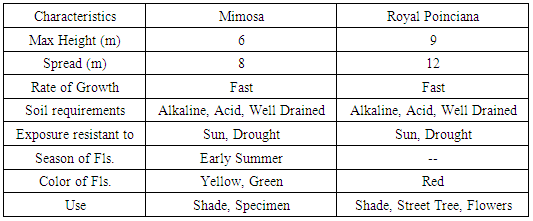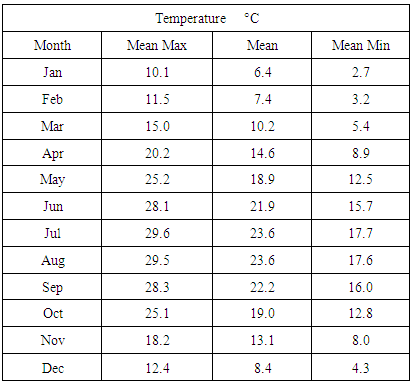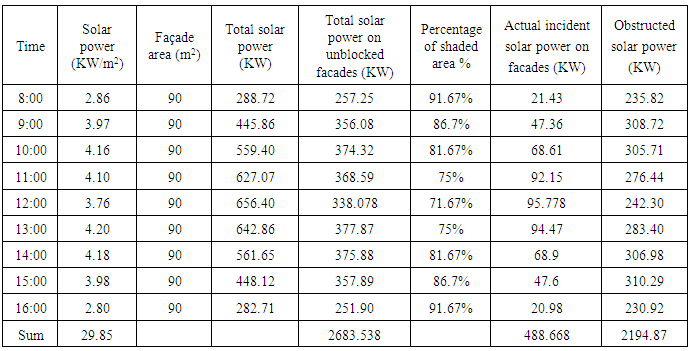-
Paper Information
- Next Paper
- Paper Submission
-
Journal Information
- About This Journal
- Editorial Board
- Current Issue
- Archive
- Author Guidelines
- Contact Us
American Journal of Environmental Engineering
p-ISSN: 2166-4633 e-ISSN: 2166-465X
2015; 5(5): 131-140
doi:10.5923/j.ajee.20150505.01

Effects of Tree Shading on Building’s Energy Consumption - The Case of Residential Buildings in a Mediterranean Climate
Dania M. Abdel-Aziz, Abdulsalam Al Shboul, Nabeel Y. Al-Kurdi
Department of Architecture, The University of Jordan, Amman, Jordan
Correspondence to: Dania M. Abdel-Aziz, Department of Architecture, The University of Jordan, Amman, Jordan.
| Email: |  |
Copyright © 2015 Scientific & Academic Publishing. All Rights Reserved.
This work is licensed under the Creative Commons Attribution International License (CC BY).
http://creativecommons.org/licenses/by/4.0/

Several studies investigated the impact of urban forests on city micro-climate. Evapotranspiration, alone or in combination with shading, can help reduce peak summer temperatures by 1–5°C (19). Tree-shade alters building cooling loads by preventing incident solar radiation on building facades. Tree-sun-building interactions influence the magnitude of this effect. The objective of this paper is to present a simplified method for making these interactions effective for dwellings in Amman, the capital of Jordan, representing a Mediterranean climate. We selected two types of trees, commonly used in residential plantation. The location of these trees around the studied building as observed in real practice. The method of analysis depended mainly on how a tree can reduce direct solar absorption by the building’s wall, when it casts shade upon a wall portion through day time. This is then subtracted from the overall cooling load; a total summation of the trees effect is then calculated. Using tree-shade as an external shading strategy showed that there is notable decrease in cooling loads; therefore, as a result there is reduction in electricity consumption. It is important for future studies to set up an energy conserving planting program criteria in Amman including tree selection and site recommendations.
Keywords: Comfort, Cooling loads, Energy saving, Passive cooling, Shading, Mediterranean climate
Cite this paper: Dania M. Abdel-Aziz, Abdulsalam Al Shboul, Nabeel Y. Al-Kurdi, Effects of Tree Shading on Building’s Energy Consumption - The Case of Residential Buildings in a Mediterranean Climate, American Journal of Environmental Engineering, Vol. 5 No. 5, 2015, pp. 131-140. doi: 10.5923/j.ajee.20150505.01.
Article Outline
1. Introduction
- Jordan suffers from an ever-present lack of sufficient energy resources. There is an increasing concern about energy consumption and its impact on the national economy as well as the local environment. Getting benefit from trees-shade to reduce air cooling energy consume will help Jordan overcome these problems. Trees have a positive impact on human comfort, wind sheltering, evaporative cooling, air-pollution reduction and shading. Getting advantage of trees-shade will help reducing energy consumption in residential buildings during summer season. A further corporate benefit is the connection between trees, green areas and human behavior.The primary goal of this study is how to use passive techniques to reduce cooling loads in residential buildings in Amman, to provide architects with information about the impact of tree-shade on energy saving in buildings. In order to achieve this goal, sub goals have been established, the first is to reduce the demand on energy; the second is to get benefit from trees-shade in achieving comfort in buildings; as well as the contribution to CO2 reduction. This study assumed that trees-shade will reduce the energy consumption in residential buildings in Amman. One of the most significant input for economic growth and human development is energy. To mitigating greenhouse-gas emissions, we should use energy in efficient ways and utilize renewable energy resources and thus to reduce the risks of possible global climate change [6].Ecologically sustainable land use planning approaches have been developed to encourage the preservation and creation of resilient natural systems, climate change and energy conservation [1]. Many researchers analyzed the impact of different facades on the energy consumption of buildings. In order to manage heat gains through facades in different seasons; facades should be designed carefully to provide effective protection against excessive solar gains in overheat periods. A good option in residential buildings could be vegetation [4]. Promoting energy conservation through cultivating natural systems can decrease electricity demand for air conditioning and expand the benefits of urban vegetation [1].Applying trees as building shading devices is an efficient passive method of solar control. In the shaded area the irradiative and thermal loads are significantly lower compared to the non-shaded ones. Trees through evaporative cooling can lower air temperature around the shaded walls. More advantages of using trees as shading devices, through reducing emissions due to the energy savings and the aesthetic influence of trees on urban landscapes [4]. Trees can provide significant improvements in the quality of the environment, including their ability to reduce atmospheric CO2 emissions and urban pollutant concentrations; as well as reducing noise levels. Trees have psychological benefits to humans related to aesthetic, emotional and physiological response to vegetated urban landscapes [2].
1.1. Trees Benefits
- Trees improve the spaces surrounding buildings aesthetically and contribute to control the ambient temperature. That is how tree plantation affects the urban micro climate in urban cities. And that explains why the consideration of green spaces is growing as an important aspect of city planning. According to (Ca et al., 1998), a nearby park can reduce the surrounding air temperature by up to 2°C [4]. This is directly related to the heat island phenomenon and how trees can reduce the effect of heat island.There are many variables that affect the cooling loads resulted from tree shade in residential buildings, building construction and occupant behavior are two of many. While there are variables that influence shading potential and the quality and quantity of shading is determined by tree species, foliar condition, canopy volume, crown shape, foliation period, leaf area, and tree location and orientation with respect to a building. With the consideration of these variables, a tree can be planted strategically to maximize energy conservation [1].Trees improve comfort conditions outdoors within the city by blocking hot and dust-laden winds. Trees can act like windbreaks that will lower the ambient wind speed; building physical characteristics will affect the building’s cooling-energy use by lowering or raising it. Trees affect a building’s energy balance as windbreaks in three ways [9]:During summer, Lower wind speed on a building envelope slows the dissipation of heat from sunlit surfaces producing higher sunlit surface temperatures and more heat gain through the building envelope.Lower wind speed results in lower air infiltration into buildings. This reduction has a major impact on reducing cooling-energy requirements for old houses.Lower wind speed reduces the effectiveness of open windows during the summer, resulting in increased reliance on mechanical cooling.
1.1.1. Evaporative Cooling
- Evaporative cooling is sufficient in hot summer days, when trees act as natural “evaporative cooler” by using up to 100 Gallons of water a day resulting to lowering the ambient temperature. The absence of leaves on deciduous trees and the lower ambient temperature minimize the effect of evapotranspiration in winter. Oasis effect can be produced from the significant increase in urban trees that will maximize the evapotranspiration in this case the ambient temperatures are significantly lower and buildings will consume less cooling energy [9].
1.1.2. Shading
- Solar radiation is the radiation from the sun, while terrestrial radiation is radiation emitted by objects on earth. Shade trees are very important in modifying both of them [20]. Tree's shade can reduce glare and block the diffused light from the sky and other surfaces this will affect the heat exchange from the building and its surrounding. Moreover, this will affect people's comfort. During the day, shade trees also indirectly reduce heat gain in buildings by altering terrestrial radiation and ultimately reducing ground surface temperatures [9] [17] [18].In summer, trees block unwanted solar radiation entering the building and hence reduce the cooling load if placed properly around the building; while in winter, trees shades increase the heating loads. Applying deciduous trees is more appropriate, since they allow solar gains during winter, while minimizing it during summer. Trees shades reduce surface temperature, glare, and blocks the diffuse radiation reflected from the sky and the surrounding surfaces, thereby alerting the heat exchange between the buildings and its surroundings. Trees block the heat flow from the building to the cool sky and surroundings at night [9].A study conducted by Heisler (1986) found that, on the south elevation a medium size deciduous tree can reduce irrandiance by 80% (with leaves on it) and 40% (if it was leafless) [15]. Trees by providing shade are an important factor in the radiative exchange process of ground and wall surfaces resulting in significant reductions of urban surface temperatures. Lack of shade in city environments, leads to higher surface and air temperatures. Therefore, shading by trees is of prime importance in reducing the ambient and surface temperatures of any artificial surface in urban built-up that will indirectly affect the building energy consumption [17].
1.2. The Impact of Tree Location on Energy Reduction
- Tree location is defined by tree-building distance and tree azimuth with respect to a building. Tree azimuth is the true compass bearing of a tree relative to a building. Changing tree location results in variation in the amount and timing of building shade [10].The methodology to select the most suitable tree take into account; land regulations and ownership, planting space, aesthetic principles, social influences, and maintenance requirements, all contribute to achieving the highest chance of successful implementation [12] [13].Many researchers have investigated the impact of tree-building location on heating and cooling energy use [11] [10] [14]. Akbari, Bretz, Hanford, Rosenfeld, Sailor, Taha, and Bos (1993) (as cited in Akbari, 2002) simulated the impact of tree locations on heating and cooling energy use and found that savings can vary from 2% to over 7%. They also claimed that cooling energy savings were higher for trees facing west surfaces. Heisler (1986), McPherson et al. (1994) and Meerow and Black (1993) found that the best two places to plant a tree around a building to reduce cooling costs is in front of west facing windows and walls and then comes in front of the east wall by providing shade for these facades in the morning and afternoon [15] [16]. A study conducted by McPherson and Simpson (2003) in California, USA studied the tree-building location and found that trees located within 12.2 m of east and west sides of buildings were in “positive sites” because trees provide benefits of shade. South trees located within 6.1 m from buildings were in “neutral sites” since benefits from limited summer shade are likely to be offset by undesirable winter shade. Trees located between 6.1 m and 12.2 m of the south side of buildings were in “negative sites” because most shade occurs during the heating season. Trees located to the north or greater than 12.2 m from buildings in other directions were in “neutral sites” because their shade would not fall on buildings [11].Although trees have the potential to save energy, but if located to shade solar collectors and south-facing windows they can reduce collector efficiency and increase winter heating costs [11].Akbari (2002) and (McPherson et al., 1994) illustrated that in order to reduce energy use in winter, the most valuable way is considered to use trees as windbreakers to the north and northwest of a building to protect buildings from the cold north winter wind. Thus the savings in heating energy of urban areas could almost be doubled [9].
2. Materials and Methods
2.1. Study Area
- The study was conducted in the city of Amman, Jordan, latitudes 32° N. It consists of an arid plateau in the east, irrigated by oasis and seasonal water streams, with highland area in the west of arable land and Mediterranean evergreen forestry. The climate of Jordan is semi-dry in summer with average temperature in the mid 30°C (86 °F) and relatively cold in winter averaging around 13°C (55 °F).
2.2. The Proposed Model
- In order to assess the impact of trees shade on summer time electricity use, this study assumed a hypothetical typical residential house that is located in Amman in a land that is categorized as Class (C) residential1. The house consists of two floors, six meters high. The house plan is 15*15 m2. The setbacks as Great Amman Municipality (GAM) regulation is; frontal setback 4(m), Side setback 3(m), Rear setback 4(m). These setbacks and the Allowable built area are applied in our model. About the trees distributions; the northern façade has no trees because it receives almost no direct solar radiation. All trees are separated 2.5 m from the walls; three trees on each elevation. The distance between each tree and another is 4m on east and west facades and 1.5 between trees located on south façade. We are getting advantage from neighbour's trees, as shown in Figure (1). We have 4 trees, 2 of them on west façade the rest is on east façade. The distance between the trees’ centres and wall is 3.5m.The estimated energy conservation as a result of trees shading were modeled in the form of saved electricity (in kWh of energy not used for air conditioning) for full-sized trees growing in eight orientations with respect to a building.
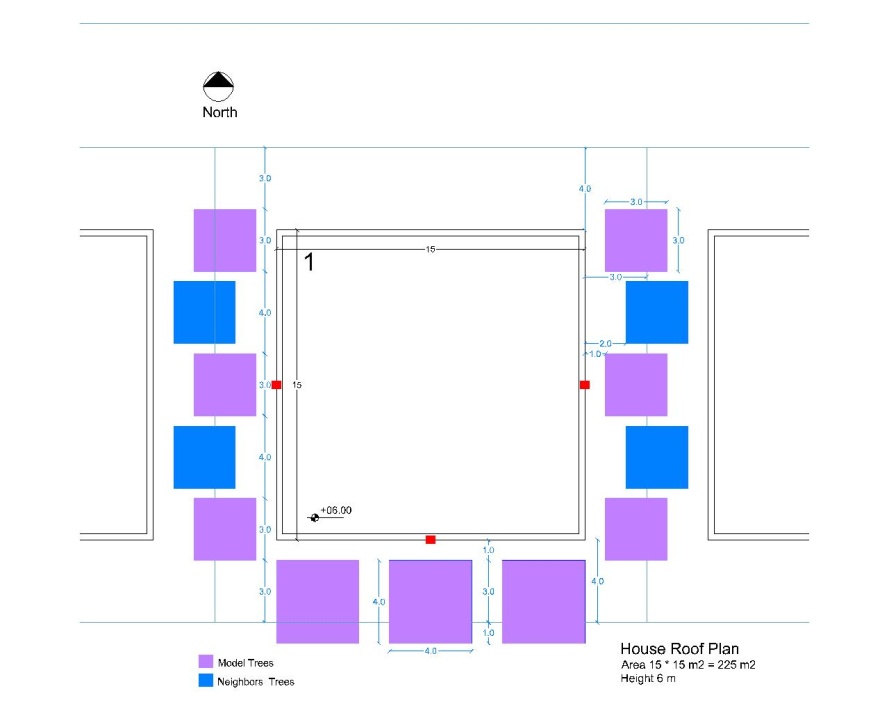 | Figure 1. Trees location around the building under consideration. (Authors, 2013) |
2.3. Tree Simplified Representation
- First it should be considered that trees can adopt many geometrical shapes in order to make it easy to calculate the shadows.The selected trees were: Mimosa (Albizia julibrissin) and Royal Poinciana (Delonix regia), check Figures 2 and 3. The two types are well known in the region for many years and they were chosen due to: Quick growing rate and lush shadow, they grow and spread in width not in height, they are available and common, relative low cost, abundant foliage and rapid growth, mostly used around buildings in the climate of Jordan. The main characteristics of the selected trees are illustrated in Table (1).
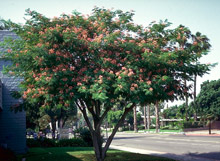 | Figure 2. Mimosa |
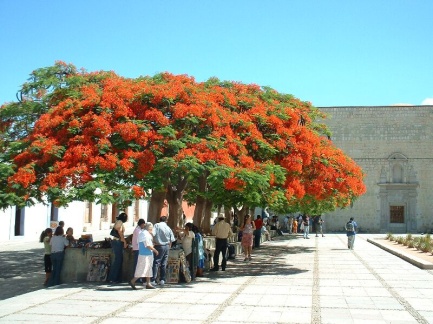 | Figure 3. Royal Poinciana |
|
3. Calculations
- For the tree shadowing evaluation, a set of parameters and algorithms need to be developed. It includes the geometrical tree representation, shading projection and blocked solar radiation simulations.To estimate the magnitude and duration of hot weather in Amman, where the shading benefits of a tree are modeled we used the concept of Cooling Degree Days (CDD). CDD is particularly useful for characterizing the potential impact of regional climate differences on cooling loads, and consequently on energy demands. A positive CDD value indicates the likelihood that electricity will be used to cool indoor spaces. CDD value is calculated for Amman city as shown in Figure (4) this calculation is based on the following summation:
 | (1) |
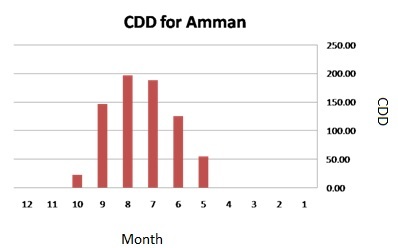 | Figure 4. Cooling Degree days for Amman city as calculated from climatic data for Amman. (Authors, 2013) |
3.1. Shading Analysis
- In order to assess the shading pattern according to the previously described setting, a shading analysis was performed. For this, the shadow outline of the surroundings is recorded for one point in the system: usually the center point of the building surface. The dimensions of shadow-casting objects are calculated. Azimuth angle and altitude angle were calculated from the equation below.
 | (2) |
3.2. Shadow Projections
- The shadow projections, both horizontal and vertical, where the center of the facade on the floor is the origin of the coordinate system, x represents the distance from the facade, y the offset of the point respect to the central orthogonal line to the facade, and z the height of the point from the floor. Figure (5) shows the angular coordinates of trees in relation to a central point on the building’s façade while Figure (6) below illustrates the coordinates of trees around the building, related to central points of the facades.
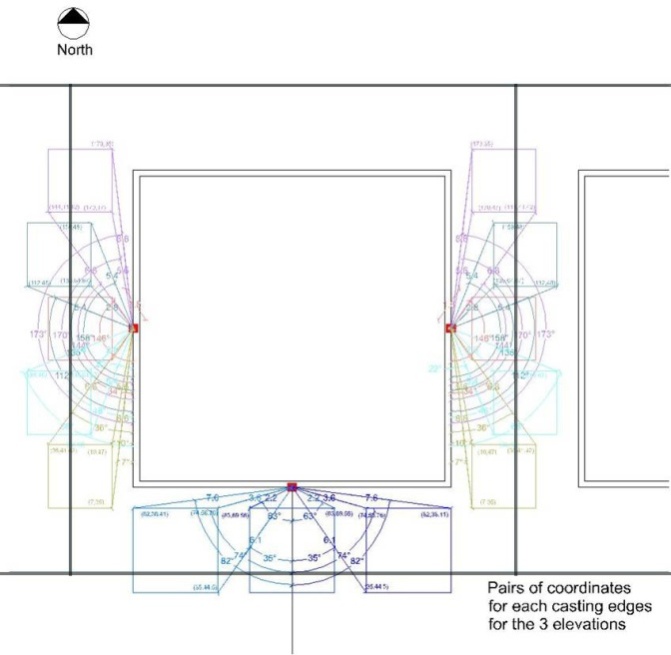 | Figure 5. Angular coordinates of trees in relation to a central point on the building’s façade. (Authors, 2013) |
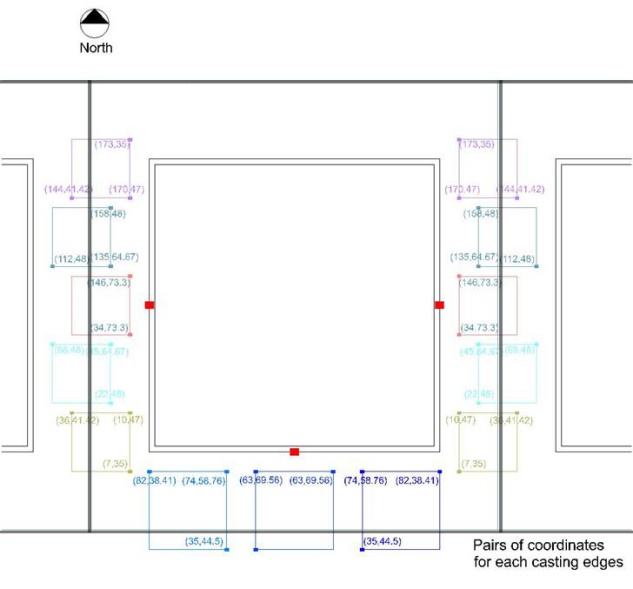 | Figure 6. Coordinates of trees around the building, related to central points of the facades. (Authors, 2013) |
3.3. Shade Calculations
- Having effective shading design contributes to reducing cooling loads in hot seasons in Amman. The energy consumption due to cooling loads will be reduced by the adoption of effective shading strategies. The simulation was conducted for the whole period of the hot season in Amman.The simulation was conducted on; July 21st, and September 21st. These targeted days represent the hot season in Amman, Table (3) represent the temperatures in Amman city. The minimum mean temperature is high in the period between July 21st, and September 21st; and the Insolation is high too. The solar radiation was estimated as a percentage of the most available incident solar radiation on building facades (east, west, and south). In order to find these variables, we followed the process below:
|
|
 | (3) |
 | (4) |
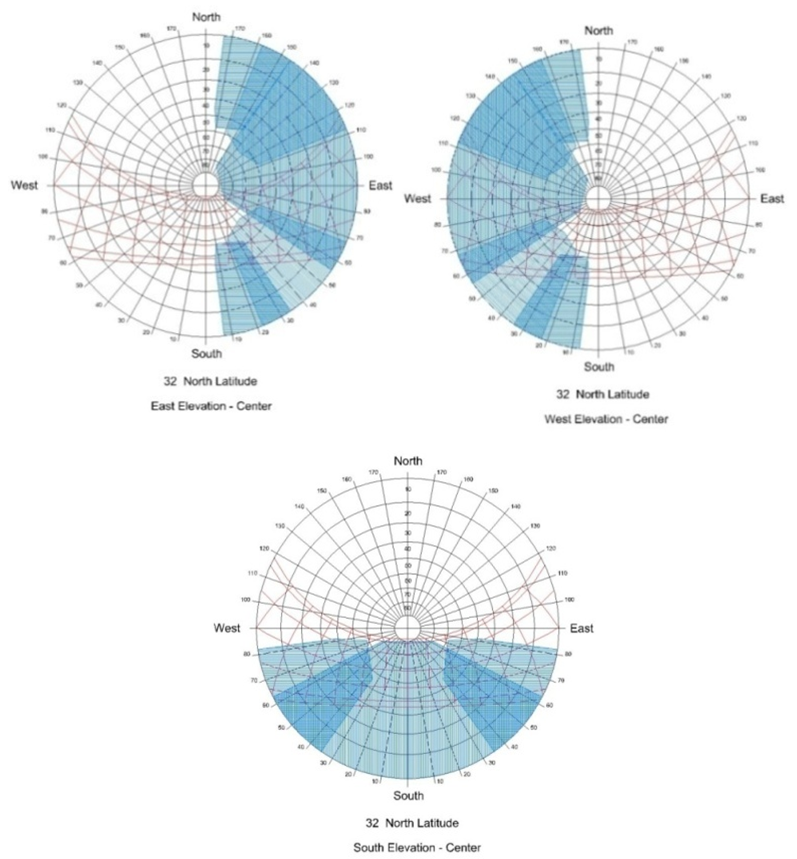 | Figure 7. Trees as obstructions viewed from the central point’s shown on the facades. Where the common area between sun paths, and shaded area represent total period of shading. (Authors, 2013) |
|
|
|
|
 | (5) |
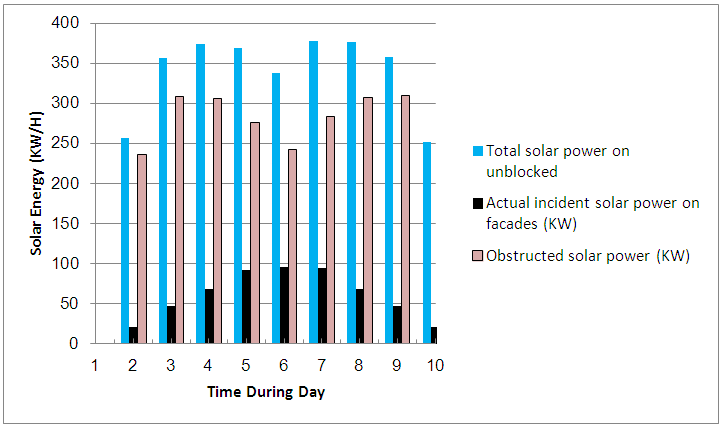 | Figure 8. Solar energy received by south facade on September 21st when trees are planted as instructed in the model (Authors, 2013) |
|
4. Results
- During the hottest summer month (July), the mean shade coverage in July 21st for our sample (on all facades) was 23.96%. As compared to a house with no shade, this indicates that the electricity use will be lowered.On September 21st, south elevation mean total solar power calculated for our solar window (9 hours, from 8am to 5pm) was 298.17 KW. When planting trees as instructed in our suggested model, actual incident solar power on facades will be reduced to 54.30 KW, a reduction of 5.5%. As noted in table (8). Shade coverage reduces electricity consumption for cooling significantly, denser shade provides significantly more cooling in the summer than does moderate or light shade [7] [8].Our findings showed the impact of tree shade on summer time energy use, increasing the overall amount of tree shade reduces energy used for cooling, late afternoon shade, typically cast from trees on the west and south sides of a building in the summertime, reduces energy consumption more than morning or early afternoon shade. There is a significant reduction in summertime residential energy consumption, as compared to no shade. This finding has implications for the tree species being planted while realizing the energy savings in the future. Such savings will benefit homeowners, maximized by tree species with dense leaf canopies during the hot summer months, trees location (offset from the façade). Tree species researched in this study are Mimosa (Albiziajulibrissin), Royal Poinciana (Delonixregia), and Common Fig (Ficuscarica). All of these species are deciduous trees, thus homeowners enjoy the benefits of reduced cooling costs during the summer, with minimum added negative impact on heating costs in winter.Homeowners ought to be aware of relevant economic benefits related to tree shade impact. People often have little knowledge or direct incentive to plant trees and/or leave trees near their homes. Unless and until these directly-affected individuals can be ‘shown the money' they will continue to make completely (to them rational) and predictable decisions that, for the most part, ignore the energy conservation benefits from shade trees [7] [8].
5. Conclusions
- Our findings coupled with literature input showed that there are potential energy savings resulting from using trees as external shading devices. A modeling method to assess the effect of tree shade was developed. Simulations have helped to better understand the impact of tree shade on cooling energy consumption. For climates such as Amman, these benefits are greatest when using deciduous trees which allow passive winter heating, exactly as suggested in our model.Besides energy consumption reduction trees can improve air quality lowering ambient temperature and hence reducing the formation of urban smog.Future studies are recommended to assess the major cost of tree planting programs. It is quite possible to design a low-cost tree-planting program.
Note
- 1. Residential category "C": is a land use category that is characterized by minimum setback as follows; front must be 4m long, side setbacks 3m and rear setback 4m. The maximum licensed area of the housing unit is 48% out of the total land area (not less than 500 square meters) (Department of Statistics, 1999).
 Abstract
Abstract Reference
Reference Full-Text PDF
Full-Text PDF Full-text HTML
Full-text HTML